Viola emarginata sensu lato [species complex]
Common names:
Triangle-leaved Violet
Synonyms:
See subordinate taxa.
Subordinate taxa belonging to this species:
Viola emarginata (Nutt.) Leconte [sensu stricto]
Viola emarginata [deltate variant]
Viola emarginata [Kentucky variant]
Viola emarginata [Lower Midwest variant]
Viola emarginata [phasmatifolia variant]
Viola emarginata [xiphophylla variant]
Description:
Acaulescent rosulate perennials from thick rhizome, ≤ 29 cm; foliage and peduncles dark blue-green, lower surface of leaf blades commonly purple-tinged, glabrous or infrequently sparsely pubescent on either surface of leaf blades, leaf blades thick and subsucculent in life; stipules free, irregularly glandular-fimbriate; largest leaf blades ≤ 84 × 75 mm, outline during chasmogamous flower narrowly ovate-triangular, oblong, oblong-ovate or narrowly deltate-triangular, during cleistogamous fruit deltate-triangular to broadly so, base truncate to subcordate, margins crenate, eciliate (occasionally ciliate), apex acute to narrowly rounded; six divergent phenotypes included in this species complex, the first four with prominentaly winged petioles and commonly with lateral and upper petal apices emarginate and spurred petal laterally compressed in life, the last two with slender less prominent petiole wings, non-emarginate petals and non-compressed spurred petal: V. emarginata sensu stricto, widespread on Atlantic Coastal Plain and Piedmont, consisting of plants (at least in chasmogamous flower) producing uncut leaf blades (more common on the northeastern Atlantic Coastal Plain) or heterophyllous plants producing larger blades pedately divided with 1–2 basal incisions or 1–3 large broadly triangular or oblong basal lobes per margin; V. emarginata [deltate variant] in the Piedmont of c. NC, a puzzling taxon unknown in chasmogamous flower or mature cleistogamous fruit, with summer leaf blades broadly deltate to deltate-reniform, terminal primary division excluding lobes lanceolate, bearing 1–2 short medial lobes on each side of terminal primary division, each primary lateral division with 3–4 short oblong lateral lobes; V. emarginata [phasmatifolia variant] in s.-c. VA and c. NC, with leaf blades resembling a walkingstick insect (e.g., Diapheromera femorata), the central axis narrowly oblong-linear, each margin with 2–4 long slender variously bent processes; V. emarginata [xiphophylla variant] in the "e;Gorges" region of sw. montane NC and adjacent SC, also somewhat disjunct in Kelly Flats area of Giles Co., VA, with the leaf blade outline commonly fancifully resembling a medieval sword, the undivided terminal primary division very long and slender (in a few individuals with a short oblong lateral lobe near the base on each side), the lateral divisions linear-falcate or often oriented perpendicular to the terminal division; V. emarginata [Lower Midwest variant] in wet prairies of s. MO and ne. OK, with undivided narrowly ovate leaf blades convexly tapering to an obtuse apex; and V. emarginata [Kentucky variant] in dry oak and pine woodlands in s. OH south to n. AL and n. LA., with undivided or very slightly basally incised narrowly ovate-triangular blades tapering uniformly from near the widest point to a sharply acute apex; chasmogamous peduncle mostly held above the leaves; chasmogamous flower ≤ 17 mm; calyx glabrous, eciliate; lowest sepals linear-lanceolate to lance-triangular, acuminate; auricles prominent, entire to erose, elongating to 5 mm in fruit; corolla violet, throat white; lateral petals densely bearded with filiform hairs, spurred glabrous or sparsely to densely bearded; cleistogamous flowers produced after chasmogamous, the peduncle erect and mostly equaling or surpassing petioles; capsule 8–12 mm, green drying tan, unspotted, glabrous; seeds 1.4–2.2 × 0.9–1.5 mm. pinkish-gray to dark gray with prominent darker streaks and spots (at least in V. emarginata sensu stricto); 2n=54.
Similar species:
The various phenotypes of this species could resemble several different violets with glabrous to glabrate foliage and leaf blades longer than broad. The whole complex has usually been subsumed under V. sagittata, while the phenotypes lacking cut leaf blades have sometimes been confused with V. fimbriatula. All phenotypes differ from most other similar species except for V. fimbriatula in their narrowly to prominently winged petioles, and from V. fimbriatula in their erect glabrous to glabrate leaves, glabrous peduncle, eciliate sepals, and cleistogamous capsule on an erect peduncle.
Ecology:
Somewhat acidic, well-drained sandy soils in oak and oak-pine forests, and open sites along forest borders and roadsides adjacent to open woodlands (V. emarginata sensu stricto, V. emarginata [phasmatifolia variant], V. emarginata [Kentucky variant], and possibly V. emarginata [xiphophylla variant]), rich mesic deciduous forest slopes (V. "emarginata deltate"), and wet prairies (V. "emarginata Lower Midwest").
Distribution:
Atlantic Coastal Plain and lower Piedmont west to Lower Midwest and se. Great Plains, MA and s. OH to s. MO south to GA and e. TX.
Rarity:
None.
Phenology:
Chasmogamous flower March–May, chasmogamous fruit April–June, cleistogamous fruit May–September.
Affinities:
This species complex belongs to the Acaulescent Blue Violet lineage, sect. Nosphinium W.Becker, subsect. Boreali-Americanae (W.Becker) Gil-ad, in the Sagittata species group.
Hybrids:
See V. emarginata sensu stricto and Viola emarginata [Lower Midwest variant].
Comments:
Brainerd (1921b), Brainerd Baird (1942), Fernald (1950), Henry (1953a), Alexander (1963), and Strausbaugh and Core (1978) accepted this species (or rather, implicitly accepted V. emarginata sensu stricto plus V. emarginata [Lower Midwest variant]); and Fernald and Alexander recognized var. acutiloba Brainerd. Russell and Risser (1960) and Russell (1965) misapplied the name to hybrids between V. affinis and V. sagittata (the type specimen is quite different), and Russell (1965) excluded the name on the basis of its inferred hybrid status. Gleason and Cronquist (1991), McKinney (1992), Ballard (2000, 2013), McKinney and Russell (2002), Haines (2011), Weakley et al. (2012), and Little and McKinney (2015) synonymized it under V. sagittata. Gil-ad (1995, 1997) dismissed it as a hybrid derivative based on Russell and Risser's interpretation and the reported absence of unique traits. The few who have continued to recognize V. emarginata as a distinct species are New Jersey and Kentucky botanists, who have noted that it is obviously very different from V. fimbriatula and V. sagittata. Herbarium specimens of V. emarginata have usually been misidentified as V. sagittata. While Viola emarginata shares certain features with V. fimbriatula and others with V. sagittata, it differs from both in a number of traits in the foliage, chasmogamous flower and seeds as noted in the keys, and has a modally different habitat especially from the haunts of V. sagittata. These observations are based on numerous herbarium specimens at more than a dozen herbaria, extensive field studies on the Atlantic Coastal Plain and Piedmont from New Jersey to North Carolina, and supplementary confirmed observations on iNaturalist. Populations and specimens studied constitute highly uniform, fully fertile taxa represented by a consistent suite of macromorphological traits including erect leaves, at least some petioles prominently winged, glabrous or sparsely appressed-hirtellous leaf blades, lower surface of blades often tinged with purple, the largest of which in chasmogamous flower through mid-summer fruit are typically deltate-triangular and either unlobed or variously lobed (in V. emarginata sensu stricto), with eciliate calyx, linear-lanceolate to lance-triangular acuminate sepals, auricles prominent and somewhat elongating in fruit, occasionally glabrous or more often sparsely to densely bearded spurred petal, upper and lateral petal apices frequently emarginate and spurred petal sometimes laterally compressed (except in the Kentucky and Lower Midwest variants), green cleistogamous capsule on erect peduncle, and brown seeds usually larger than those found in related species (e.g., V. fimbriatula and V. sagittata). Brainerd reported that hybrids with the latter were variously nearly sterile to subfertile.
While quite distinct from other Borealiamericanae species, this complex encompasses considerable diversity of phenotypes, at least insofar as vegetative features express; aside from Viola emarginata sensu stricto, which has been reasonably well studied, the other five taxa remain poorly understood. The four taxa east of the spine of the Appalachian Mountains, Viola emarginata sensu stricto, Viola emarginata [phasmatifolia variant], Viola emarginata [xiphophylla variant] and Viola emarginata [deltate variant], have more prominently broad-winged petioles, as well as flowers commonly with emarginate lateral and upper petals and a laterally compressed spurred petal; the first three phenotypes prefer dry sandy soils in oak and oak-pine forests, while the few specimens of the peculiar Viola emarginata [deltate variant] were collected on richer mesic forest slopes. The two taxa distributed west of the Appalachian Mountains, Viola emarginata [Kentucky variant] and Viola emarginata [Lower Midwest variant], have inconspicuously narrowly winged petioles, and flowers with rounded lateral and upper petals and a non-compressed spurred petal. The Kentucky variant is found in dry sandy soils in oak and oak-pine forests similar to most phenotypes east of the Appalachian Mountains, while Viola emarginata [Lower Midwest variant] has only been taken in wet prairies. All of these ecological niches are quite different from those frequented by V. sagittata, with which V. emarginata sensu lato has previously been merged. The assemblage is treated here as a distinct evolutionary species complex. The variants are currently under study to determine whether subspecies or species status is appropriate.
Literature Cited:
Alexander, E. J. 1963. Violaceae. In Gleason, H. A., The new Britton and Brown illustrated flora of the northeastern United States and adjacent Canada. Hafner Publishing Co., Inc., New York, NY. 552-567.
Ballard Jr., H. E. 2000. Violaceae. In Rhoads, A. (ed.). Flora of Pennsylvania. University of Pennsylvania Press, Philadelphia, PA. 700-710.
Ballard Jr., H. E. 2013. Violaceae. In Yatskievych, G., Flora of Missouri. Missouri Botanical Garden Press, St. Louis, MO. 1218-1243.
Brainerd, E. 1921b. Violets of North America. Vermont Agricultural Experiment Station Bulletin 224: 1–172.
Brainerd Baird, V. 1942. Wild violets of North America. University of California Press, Berkeley, CA.
Fernald, M. L. 1950. Violaceae. In Gray’s Manual of Botany, 8th ed. American Book Company, New York, NY. 1022-1042.
Gil-ad, N. L. 1995. Systematics and evolution of Viola L. subsection Boreali-Americanae (W. Becker) Brizicky. Ph.D. dissertation. University of Michigan, Ann Arbor, MI.
Gil-ad, N. L. 1997. Systematics of Viola subsection Boreali-Americanae. Boissiera 53: 1–130.
Gleason, H. A. and A. Cronquist. 1991. Violaceae. In Manual of vascular plants of northeastern United States and adjacent Canada, 2nd ed. New York Botanical Garden, Bronx, NY. 157-163.
Haines, A., E. Farnsworth, and G. Morrison. 2011. Violaceae. In Flora Novae Angliae. Yale University Press, New Haven, CT. 873-886.
Henry, L. K. 1953a. The Violaceae in western Pennsylvania. Castanea 18(2): 37-59.
Little, R. J., and L. E. McKinney. 2015. Violaceae. In Flora of North America: Cucurbitaceae to Droseraceae, 106. Oxford University Press, New York, NY.
McKinney, L. E. 1992. A taxonomic revision of the acaulescent blue violets (Viola) of North America. Sida, Botanical Miscellany 7: 1–60.
McKinney, L. E., and N. H. Russell. 2002. Violaceae of the southeastern United States. Castanea 67: 369–379.
Russell, N. H., and A. C. Risser Jr. 1960. The hybrid nature of Viola emarginata. Brittonia 12: 298–305.
Russell, N. H. 1965. Violets (Viola) of the central and eastern United States: An introductory survey. Sida 2: 1-113.
Strausbaugh, P. D. and E. L. Core. 1978. Violaceae. In Flora of West Virginia, 2nd ed. Seneca Books, Inc., Morgantown, WV. 644-658.
Weakley, A. S., J. C. Ludwig, and J. F. Townsend. 2012. Violaceae. In Flora of Virginia. BRIT Press, Fort Worth, TX. 963-975.
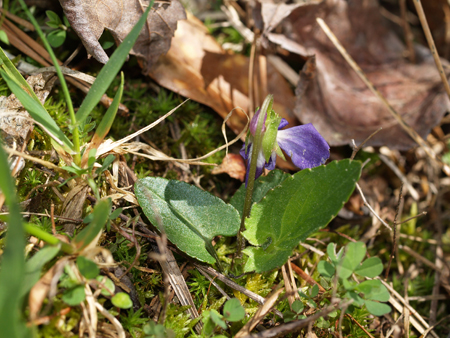
Chasmogamous flowering habit of V. emarginata sensu stricto by Harvey Ballard
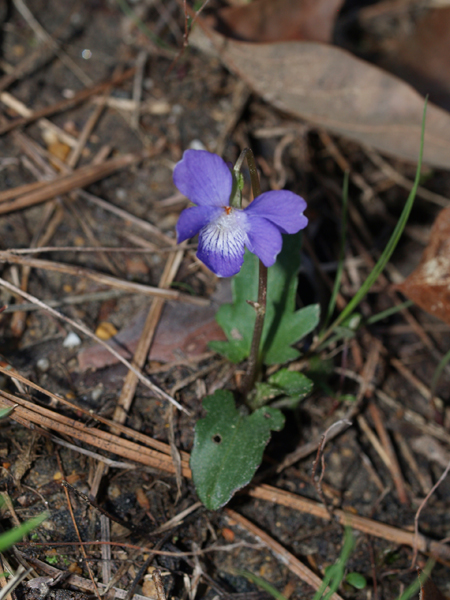
Chasmogamous flowering habit of V. emarginata sensu stricto by Harvey Ballard

Cleistogamous fruiting habit of V. emarginata [deltate variant] by Harvey Ballard
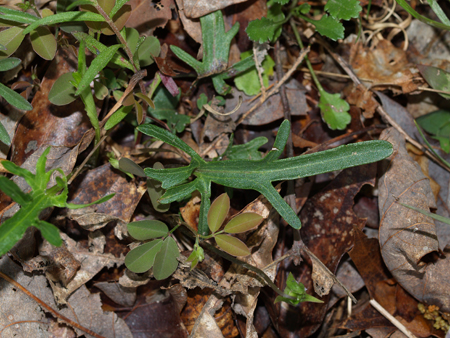
Leaves of V. emarginata [phasmatifolia variant] by Harvey Ballard
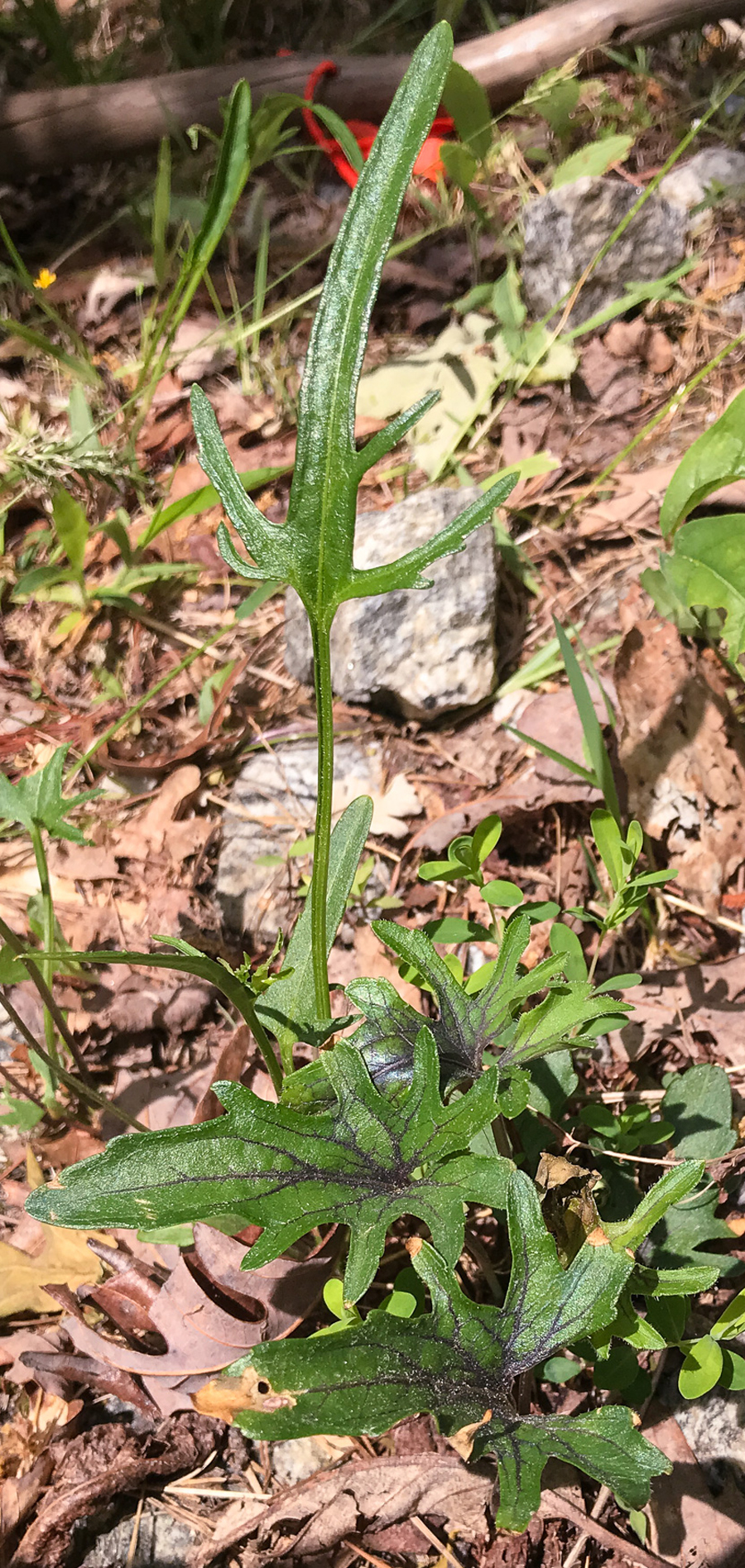
Leaves of V. emarginata [xiphophylla variant] by Harvey Ballard
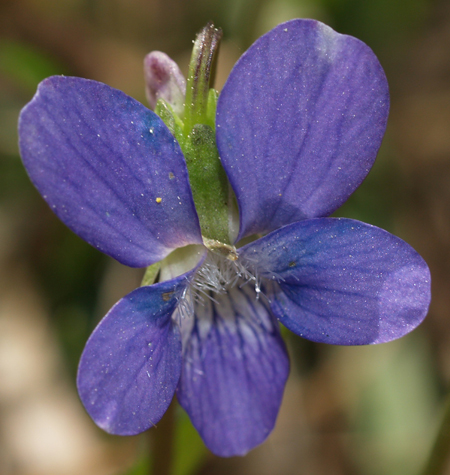
Chasmogamous flower front view of V. emarginata sensu stricto by Harvey Ballard
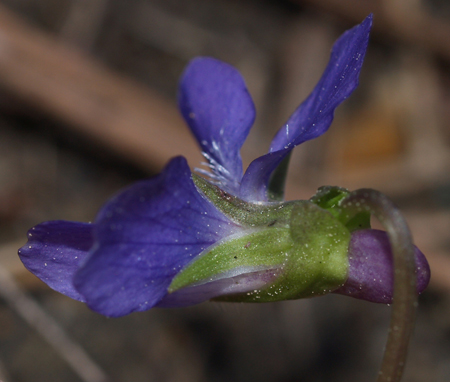
Chasmogamous flower profile view of V. emarginata sensu stricto by Harvey Ballard

Seeds from herbarium specimen of V. emarginata sensu stricto: Transplanted from NC, Cumberland Co., Fort Bragg, H. Ballard 15-006Y (BHO)
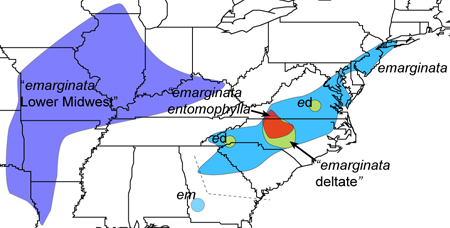
Map by Biota of North America Program